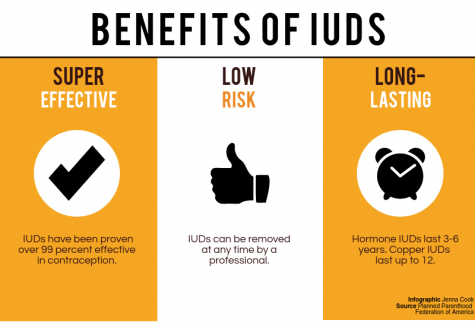IUDs provide more protection against pregnancy
Long-term birth control beneficial to teens
November 14, 2017
With adolescence comes a strong sexual drive to many teens, which makes effective birth control all the more practical for high schoolers. Two of the best means of contraception for teens are Intrauterine Devices (IUDs) and birth control implants. Both methods release progestin, a hormone that prevents sperm cells from reaching the egg. IUDs are small T-shaped devices inserted to a female’s uterus, while the implant is a matchstick-shaped device inserted into one’s arm.
Although the birth control pill is one of the most common methods of contraception, it is not as effective as an arm implant or an IUD and can be easily forgotten. IUDs and implants, once inserted, can be forgotten until the recipient is ready to have it removed or it is finished serving its purpose, making them more convenient as well as effective.
Birth control pills can be cheaper in the short term, at around $15-$50 per month depending on insurance, but IUDs and implants can both be averaged to around $40 dollars or less per month, depending on how long they last and the patient’s insurance. While the cost of longer-term contraception may seem intimidating at first, it is manageable for anyone who already uses birth control pills.
Implants and IUDs are both about 99 percent effective in contraception, but neither protect from sexually transmitted infections (STIs). Male and/or female condoms should still be used during penetrative sex to lessen the risk of getting an STI. STIs can cause pain, discomfort, and in some cases death, depending on the infection. STIs are commonly passed from person to person via unprotected sex, and passing can usually be prevented with a condom or other physical barrier. Unless all involved parties have been tested and cleared for STIs, condoms are a must. Testing is important as some infections are symptomless but can cause damage in the long run.
Although teen birth rates in the U.S. have dropped around 20 percent since 2007, teen pregnancy remains a problem. Most teens who give birth do not complete high school, which leaves them behind in today’s fast-paced and competitive economic society. Only around half of teenage mothers earn a high school diploma by age 22, which leaves them behind their peers who earned diplomas at 18. Teen mothers get a later start in their adult life, especially if they are not able to financially support a child.
Educating teens, especially those who are sexually active, about these methods of contraception and encouraging them to get a form of birth control could greatly decrease teen pregnancy rates in the U.S.. A median of 65.2 percent of urban schools requires sex education teachers to teach students about IUDs and about 23 percent of public schools enforce an abstinence-only sex education curriculum. This leaves some studen ts without any knowledge of contraception besides abstinence, which does not help in delaying sexual initiation.
ts without any knowledge of contraception besides abstinence, which does not help in delaying sexual initiation.
Contraception is important in high school because an individual getting pregnant before they are ready can have consequences for themselves and their child. Children of teenage mothers are more likely to have health problems, be incarcerated during their adolescence and parent a child of their own while still a teenager. Any form of contraception is important for sexually active teens. If not for one’s self, one should use contraception for their would-be child.
While condoms and birth control pills may be enough for some people, those who want to be seriously protected from pregnancy until they are ready should take long-term birth control into consideration. While contraception should be one person’s choice based on their own beliefs or concerns, if teens will not abstain from sex throughout adolescence, contraception should be considered and applied to prevent teen pregnancy rates from rising once again.




